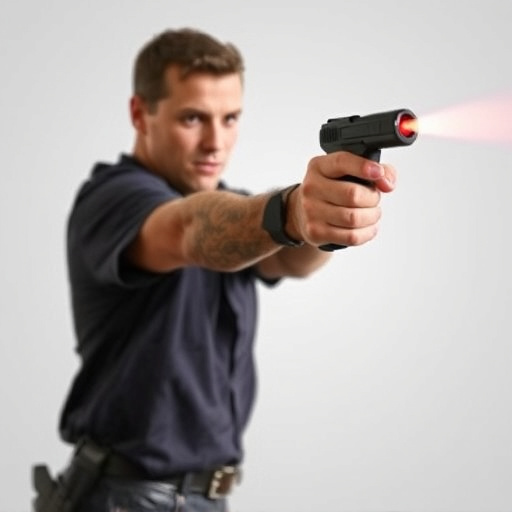Non-lethal deterrents like bear spray are crucial for personal security in outdoor and rural environments, aiming to temporarily incapacitate bears without permanent harm. Effective use requires mastering application techniques, focusing on the face and eyes from 3-4 feet away with quick bursts, ensuring maximum coverage of capsaicin irritants. Regular training, practice, maintenance, and awareness of expiration dates are vital for reliable performance in high-stress situations. The best techniques involve accuracy, aiming for specific facial and chest targets at close range, and using the right amount to disorient bears, prioritizing prevention and distance as primary safety measures.
“Personal security is a top priority, especially outdoors. This comprehensive guide explores non-lethal deterrent devices, with a focus on bear spray – a powerful yet humane personal safety tool. We delve into the science behind these deterrents and provide an in-depth look at their effectiveness.
From understanding the basics of non-lethal force to mastering the best bear spray application techniques, this article equips readers with knowledge to make informed choices for their outdoor adventures. Discover how to choose the right self-defense device to suit your needs and stay safe.”
- Understanding Non-Lethal Deterrents: A Comprehensive Overview
- The Role of Bear Spray in Personal Safety
- Effective Bear Spray Application Techniques
- Choosing the Best Non-Lethal Self-Defense Device for Your Needs
Understanding Non-Lethal Deterrents: A Comprehensive Overview
Non-lethal deterrents, like bear spray, have become essential tools for personal security, especially in outdoor and rural settings. These devices are designed to incapacitate or deter an assailant temporarily without causing permanent harm, making them a popular choice for individuals seeking effective self-defense options. Bear spray, in particular, is known for its effectiveness against large wild animals like bears, but it can also be used against humans when deployed correctly.
Understanding the best bear spray application techniques is crucial. Aiming for the face and eyes, typically at close range (3-4 feet), ensures maximum efficacy. The key is to project a generous amount of spray directly onto the target area, creating a visual and respiratory obstacle. Proper training and practice are vital to ensure users can deploy the spray accurately and swiftly in high-stress situations. Regular maintenance and awareness of expiration dates also contribute to the overall effectiveness of these devices, making them reliable companions for outdoor adventures.
The Role of Bear Spray in Personal Safety
Bear spray, also known as bear repellent, has emerged as a crucial non-lethal deterrent for personal safety in areas frequented by bears. When used correctly, it can create a protective barrier, enabling individuals to defend themselves against aggressive bear encounters. The key to its effectiveness lies in the best bear spray application techniques.
The optimal method involves aiming directly at the bear’s face and eyes from a safe distance, typically around 20-30 feet. Spraying in quick bursts, rather than a continuous stream, ensures maximum coverage while minimizing the risk of missing the target. It’s important to follow product instructions regarding spray patterns and angles for best results. Proper application allows the spray’s capsaicin and other active ingredients to irritate the bear’s sensory organs, temporarily disorienting it and providing valuable time for retreat or safety.
Effective Bear Spray Application Techniques
When it comes to effective bear spray application, understanding the best techniques is crucial for personal safety in bear country. The key lies in aiming accurately and using the right amount. Start by ensuring a clear line of sight between yourself and the bear, keeping it centered in your field of view. At close range, aim for the bear’s face, eyes, and nose—this area is highly sensitive and will cause the bear to retreat. If you’re at a distance, aim for a group of patches just below the bear’s chest, as this targets the respiratory system without risking non-lethal injuries.
Practice makes perfect; train with a mock spray or target practice to refine your technique. Remember, bear spray is a tool of last resort; always prioritize prevention and distance yourself from bears whenever possible. Proper application ensures that you’re prepared if a defensive encounter becomes necessary.
Choosing the Best Non-Lethal Self-Defense Device for Your Needs
When considering a non-lethal self-defense device, understanding your specific needs and environment is crucial. Different scenarios call for diverse deterrents, and knowing what works best in various situations can help ensure your safety. For outdoor enthusiasts and those in rural areas, bear spray is an excellent option. It’s highly effective against large animals like bears and cougars, and proper application techniques are key to its success. Learning the best practices for bear spray involves understanding wind patterns, aiming correctly, and knowing how much spray to use.
Training sessions and tutorials can equip individuals with the skills to deploy these devices effectively. Additionally, considering factors like range, durability, weight, and ease of use will help you choose a non-lethal deterrent that suits your lifestyle and offers peace of mind.
In conclusion, non-lethal deterrent devices, particularly bear spray, offer a powerful yet safe option for personal security in various outdoor scenarios. By understanding the dynamics of these deterrents and mastering the best bear spray application techniques, individuals can effectively protect themselves against potential threats. Choosing the right device that suits your specific needs is key to ensuring peace of mind during your adventures. Remember, knowledge and preparation are paramount when it comes to personal safety in nature.
